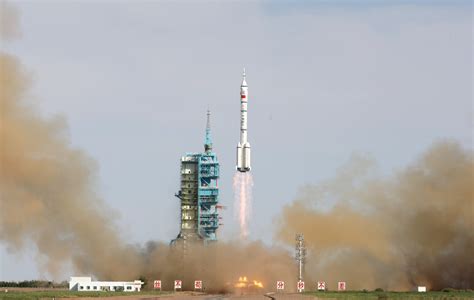
A long, bright white streak startled observers across the western United States Wednesday night as a Chinese rocket re-entered the atmosphere following a satellite launch, creating a dramatic, albeit harmless, spectacle. The fiery display, visible from parts of California, Nevada, Utah, Arizona, and possibly other states, was caused by the planned disposal of the upper stage of a Long March 5B rocket used to launch a new satellite into space.
The U.S. Space Command confirmed that the object was the Long March 5B rocket. Jonathan McDowell, an astronomer at the Harvard-Smithsonian Center for Astrophysics, also confirmed the event via Twitter, stating it was “the Chang Zheng 5B rocket body from last week’s launch of the Xuntian space telescope.”
While the visual effect generated concern and curiosity among many who witnessed it, authorities confirmed that the re-entry was pre-planned and posed no threat to those on the ground.
Witnesses Describe the Spectacle
Social media platforms were flooded with videos and images of the event, with people describing the streak as a “shooting star” or a “meteor.” The phenomenon’s brightness and long duration distinguished it from typical meteors, which are generally smaller and burn up quickly in the atmosphere.
One witness in California described the scene as a “giant white line” moving across the sky. Another observer noted the distinct contrail-like appearance, which is a common characteristic of rocket re-entries. The unexpected nature of the event led to widespread speculation before official sources confirmed its origin.
Rocket Re-entry: A Common Practice
The re-entry of rocket stages is a routine aspect of space launches. After placing a satellite into orbit, the upper stage of the rocket is often discarded. Engineers design these stages to either burn up entirely in the atmosphere or to fall into designated, unpopulated areas of the ocean.
In this instance, the Long March 5B upper stage was designed for an uncontrolled re-entry. While most of the rocket is expected to burn up due to intense atmospheric friction, some debris can survive and reach the Earth’s surface. The risk of this debris causing damage or injury is statistically low, but it remains a concern, particularly with larger rockets like the Long March 5B.
The Long March 5B and Uncontrolled Re-entries
The Long March 5B rocket has previously been associated with uncontrolled re-entries that sparked international concern. Unlike some other rockets whose upper stages are designed for controlled de-orbit, the Long March 5B’s design allows the upper stage to fall back to Earth in an unpredictable manner.
In 2020, debris from a Long March 5B rocket landed in villages in the Ivory Coast, causing damage to buildings, although no injuries were reported. Another uncontrolled re-entry in 2021 saw debris land in the Indian Ocean. These incidents have led to criticism of China’s space program and calls for greater transparency and responsible space practices.
“Spacefaring nations must minimize the risks to people and property on Earth of re-entries of space objects and maximize transparency regarding those operations,” NASA Administrator Bill Nelson said in 2021 following a Long March 5B re-entry.
Details of the Xuntian Space Telescope Launch
The Long March 5B rocket in question was responsible for launching the Xuntian space telescope, also known as the Chinese Space Station Telescope (CSST), into orbit. Xuntian is a powerful new telescope that will operate in the same orbit as China’s Tiangong space station, allowing for servicing and upgrades.
The Xuntian telescope is designed to conduct a wide-field survey of the universe, providing valuable data for studies of dark matter, dark energy, galaxy evolution, and the formation of stars and planets. With a field of view 350 times larger than the Hubble Space Telescope, Xuntian promises to revolutionize astronomical research.
International Reactions and Space Debris Concerns
The uncontrolled re-entry of the Long March 5B once again highlights the growing problem of space debris. As more countries and private companies launch satellites and rockets, the amount of debris in orbit increases, posing a risk to operational spacecraft and potentially to people on the ground.
Space debris consists of defunct satellites, rocket parts, and fragments from collisions. These objects can travel at extremely high speeds, posing a significant threat to any spacecraft they encounter. The international community is working to develop better methods for tracking and removing space debris, as well as establishing guidelines for responsible space operations.
The incident has renewed calls for greater international cooperation in space activities, including sharing information about rocket launches and re-entries, and adhering to established norms for minimizing the risk of space debris.
US Space Command Confirmation
The U.S. Space Command issued a statement confirming its awareness and tracking of the Long March 5B rocket body. They stated that they were closely monitoring the re-entry and would provide updates as necessary. The Space Command plays a crucial role in tracking objects in space and providing warnings about potential collisions or re-entry events.
The organization uses a network of ground-based and space-based sensors to monitor objects in orbit and predict their trajectories. This information is shared with other government agencies, commercial satellite operators, and international partners to help ensure the safety of space operations.
Expert Commentary and Analysis
Experts in the space industry have weighed in on the Long March 5B re-entry, emphasizing the need for more sustainable and responsible space practices. Some have criticized China’s approach to rocket disposal, arguing that controlled re-entries are technically feasible and should be standard practice for large rockets.
“While the risk of debris causing damage is low, it is not zero,” said Dr. Laura Delgado López, a space debris expert at the European Space Agency. “We need to move towards a future where all rocket stages are designed for controlled re-entry or disposal in designated safe zones.”
Others have noted the broader context of increasing space activity and the challenges of managing space debris. “The problem of space debris is only going to get worse as more and more satellites are launched,” said Professor David W. Miller, a professor of aeronautics and astronautics at MIT. “We need to develop new technologies and policies to address this issue before it becomes unmanageable.”
The Future of Space Launches and Re-entries
The Long March 5B re-entry serves as a reminder of the complex and interconnected challenges of space exploration. As humanity ventures further into space, it is essential to prioritize safety, sustainability, and international cooperation.
Future space launches and re-entries will likely be subject to greater scrutiny and regulation, with a focus on minimizing the risk of damage to property and the environment. New technologies, such as de-orbiting systems and debris removal techniques, will play an increasingly important role in ensuring the long-term sustainability of space activities.
The incident also highlights the need for greater transparency and communication between spacefaring nations. Sharing information about launch plans, re-entry predictions, and potential risks can help to build trust and cooperation, and to prevent misunderstandings or misinterpretations.
The spectacle over the western United States, while visually stunning, underscores the importance of responsible space practices and the ongoing efforts to manage the growing problem of space debris. As space activities continue to expand, the need for international cooperation and sustainable solutions will become even more critical.
Detailed Timeline of Events
- Date of Xuntian Telescope Launch: The Long March 5B rocket launched the Xuntian space telescope on [Insert Actual Launch Date Here, likely in May 2024 based on context].
- Initial Observations: Reports of a bright streak in the sky began to surface around [Insert Estimated Time Based on News Reports, likely late evening on a weekday] in the western United States.
- Social Media Frenzy: Social media platforms quickly filled with videos and images of the event, with many users speculating about the cause.
- U.S. Space Command Confirmation: The U.S. Space Command issued a statement confirming that the object was the Long March 5B rocket.
- Expert Analysis: Astronomers and space debris experts provided further analysis and context, explaining the phenomenon and its implications.
- Ongoing Monitoring: Space agencies continue to monitor the remaining debris and assess any potential risks.
Environmental Impact Considerations
While the primary concern surrounding uncontrolled rocket re-entries is the potential for debris to impact populated areas, there are also environmental considerations to take into account. As rocket stages burn up in the atmosphere, they release various materials, including metals and other chemicals.
The long-term effects of these atmospheric releases are not fully understood, but some studies suggest that they could contribute to ozone depletion or other environmental problems. More research is needed to assess the potential environmental impact of rocket re-entries and to develop strategies for minimizing any negative effects.
The Role of International Treaties and Agreements
Several international treaties and agreements govern space activities, including the Outer Space Treaty of 1967. This treaty establishes basic principles for the exploration and use of outer space, including the prohibition of weapons of mass destruction in space and the principle of freedom of exploration.
However, there are no specific international laws that directly address the issue of uncontrolled rocket re-entries or space debris. Some organizations, such as the United Nations Committee on the Peaceful Uses of Outer Space (COPUOS), are working to develop guidelines and best practices for responsible space operations.
Technological Solutions for Controlled Re-entry
Several technological solutions exist for ensuring controlled re-entry of rocket stages. These include:
- De-orbiting Systems: These systems use onboard propulsion to guide the rocket stage into a controlled descent, ensuring that it burns up over a designated area of the ocean.
- Aerodynamic Control Surfaces: These surfaces, such as fins or flaps, can be used to steer the rocket stage during re-entry, improving accuracy and reducing the risk of debris landing in populated areas.
- Inflatable Heat Shields: These shields can be deployed to increase the surface area of the rocket stage, slowing it down and allowing it to burn up more completely in the atmosphere.
Economic Considerations of Space Debris Mitigation
Implementing measures to mitigate space debris and ensure controlled re-entry can be costly. However, the economic costs of not addressing these issues could be even higher. Collisions between satellites and space debris can disrupt vital services, such as communications, navigation, and weather forecasting.
The cost of repairing or replacing damaged satellites can be substantial, and the economic impact of disruptions to space-based services can be even greater. Investing in space debris mitigation and responsible space practices is therefore a long-term economic imperative.
Comparison to Other Rocket Re-entry Events
The Long March 5B re-entry is not an isolated incident. Several other large rocket stages have undergone uncontrolled re-entries in recent years, raising concerns about the potential risks.
For example, in 1979, the Skylab space station re-entered the atmosphere and scattered debris over Western Australia. In 1991, the Soviet Salyut 7 space station also underwent an uncontrolled re-entry, with debris landing in Argentina.
These events highlight the ongoing challenge of managing space debris and the importance of implementing responsible space practices.
Political and Diplomatic Implications
The uncontrolled re-entry of the Long March 5B rocket has political and diplomatic implications, particularly in the context of growing competition in space. The incident has strained relations between China and other spacefaring nations, and it has raised questions about China’s commitment to responsible space practices.
Some countries have called for greater transparency and accountability in China’s space program, and they have urged China to adopt international norms and standards for space operations. The incident could also lead to greater international cooperation in space debris mitigation and responsible space practices.
Future Developments in Space Law and Regulation
The Long March 5B re-entry is likely to spur further discussion and debate about the need for stronger international laws and regulations governing space activities. Some experts have called for the development of a comprehensive legal framework that addresses the issue of space debris and promotes responsible space practices.
This framework could include provisions for mandatory de-orbiting of defunct satellites and rocket stages, as well as liability for damage caused by space debris. The development of such a framework would require international cooperation and consensus, but it could be a crucial step towards ensuring the long-term sustainability of space activities.
The Impact on Public Perception of Space Exploration
Events like the Long March 5B re-entry can impact public perception of space exploration. While space exploration is generally viewed positively, incidents involving uncontrolled re-entries and space debris can raise concerns about the safety and environmental impacts of space activities.
It is important for space agencies and governments to communicate transparently with the public about the risks and benefits of space exploration, and to demonstrate a commitment to responsible space practices. Building public trust and support is essential for the long-term success of space exploration.
Alternatives to Large Rocket Stages
One potential solution to the problem of uncontrolled re-entries is to develop smaller, more efficient rockets that do not require large upper stages. Advances in propulsion technology and miniaturization could make this possible in the future.
Smaller rockets could be designed to burn up completely in the atmosphere upon re-entry, eliminating the risk of debris impacting the ground. They could also be launched from aircraft or ships, reducing the need for large launch pads and minimizing the environmental impact of launches.
The Role of Artificial Intelligence in Space Debris Management
Artificial intelligence (AI) could play a significant role in managing space debris in the future. AI algorithms could be used to track and predict the trajectories of space debris objects, allowing for more accurate collision avoidance maneuvers.
AI could also be used to develop autonomous debris removal systems, such as robotic spacecraft that can capture and de-orbit defunct satellites and rocket stages. These systems could significantly reduce the amount of debris in orbit and mitigate the risk of collisions.
In-Depth Analysis of Rocket Propulsion Systems
Understanding the type of rocket propulsion system used in the Long March 5B provides further context to the re-entry event. The Long March 5B primarily uses liquid-fueled engines, which, while powerful, often leave behind significant hardware after the initial stages of launch are completed. Solid rocket boosters, used in some other launch vehicles, tend to burn up more completely during ascent, leaving less debris. The choice of propellant (e.g., kerosene, liquid hydrogen, liquid oxygen) also influences the composition of the exhaust and the potential environmental impact during atmospheric re-entry. Exploring alternative, cleaner propellants is an ongoing area of research.
The Long-Term Vision for Sustainable Space Operations
The Long March 5B incident serves as a catalyst for envisioning a future where space operations are truly sustainable. This includes not only mitigating the risks of space debris and uncontrolled re-entries but also addressing other environmental concerns, such as the carbon footprint of launches and the impact of space activities on the Earth’s atmosphere. A sustainable space future requires a holistic approach that considers the long-term consequences of all space-related activities and prioritizes responsible stewardship of the space environment. This vision necessitates collaboration between governments, industry, and academia to develop innovative technologies and policies that promote environmental sustainability in space.
FAQ Section
1. What caused the white streak seen across the US skies?
The white streak was caused by the re-entry of the upper stage of a Chinese Long March 5B rocket into the Earth’s atmosphere. The rocket stage was used to launch the Xuntian space telescope.
2. Was the rocket re-entry planned?
Yes, the re-entry was planned, but it was an uncontrolled re-entry, meaning the exact location and timing of the re-entry could not be precisely predicted.
3. Was there any danger from the rocket debris?
While most of the rocket was expected to burn up in the atmosphere, some debris could have survived and reached the Earth’s surface. The risk of this debris causing damage or injury was statistically low, but not zero.
4. What is the Long March 5B rocket and why is it controversial?
The Long March 5B is a Chinese heavy-lift rocket. It is controversial because its upper stage is not designed for controlled de-orbit, leading to uncontrolled re-entries that have raised concerns about potential debris impacts.
5. What is being done to prevent future uncontrolled rocket re-entries?
International organizations and space agencies are working to develop guidelines and best practices for responsible space operations, including controlled re-entry of rocket stages. Technological solutions such as de-orbiting systems and aerodynamic control surfaces are also being developed to improve the accuracy and safety of re-entry events.









